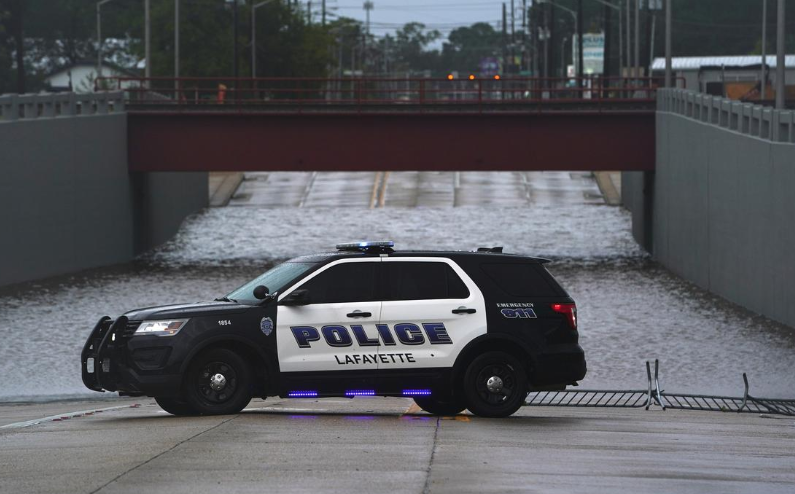HOUSTON, Texas (Reuters) – Hurricane Laura made landfall early on Thursday in southwestern Louisiana as one of the most powerful storms to hit the state, shattering glass windows and tearing roofs off buildings in Lake Charles as it moved northward to drench the inland.
The windows of the city’s 22-floor Capital One Tower were blown out, street signs were toppled and pieces of wooden fences and debris from collapsed buildings lay in the streets, video footage on Twitter and Snapchat showed.
Laura made landfall just before 1 a.m. as a Category 4 storm packing winds of 150 mph (240 kph) in the small town of Cameron, Louisiana, the National Hurricane Center (NHC) said.
It rapidly weakened to a Category 2 storm Thursday morning with maximum sustained winds of 100 mph (160 kph), and was forecast to become a tropical storm later in the day. However, the NHC warned that the threat of possibly deadly storm surge would continue along the Louisiana coast as Laura moved north and then northeast.
The area where Laura made landfall in Cameron Parish has a population of just under 7,000 and is home to a national wildlife refuge. The marshland there is particularly vulnerable to the storm surge of ocean water.
“This is one of the strongest storms to impact that section of coastline,” said David Roth, a National Weather Service forecaster. “We worry about that storm surge going so far inland there because it’s basically all marshland north to Interstate 10. There is little to stop the water.”
The storm surge, which the NHC on Wednesday predicted would be “unsurvivable,” was still forecast to raise water levels up to 20 feet (6 meters) in parts of Cameron Parish, Louisiana, on Thursday morning.
“This surge could penetrate up to 40 miles inland from the immediate coastline, and flood waters will not fully recede for several days after the storm,” the NHC said on Thursday.
Department of Homeland Security acting Secretary Chad Wolf told Fox News on Thursday that the Federal Emergency Management Agency (FEMA) had pre-positioned teams throughout Texas, Louisiana, Mississippi, Alabama and Georgia to respond as the sun rose.
“The next 48 hours are really going to be critical from a life safety standpoint,” Wolf said.
TEXAS MOSTLY SPARED
Almost 400,000 homes and businesses in Louisiana and Texas were without power early Thursday, and local utilities in the storm’s path warned the outage numbers would certainly climb as the storm marched inland.
The eastern coastal counties of Texas that had braced for the worst were largely spared Laura’s rage. Galveston’s acting mayor, Craig Brown, told MSNBC he was canceling the island city’s evacuation on Thursday after the storm turned more toward Louisiana and was offering emergency support to communities hit harder to the east. Beaumont, Texas, Mayor Becky Ames told MSNBC the situation there was “manageable.”
Louisiana Governor John Bel Edwards told CNN early Thursday that there were no known fatalities in his state yet.
“I don’t know how long that will hold up, but that’s a blessing,” Edwards said.
Laura could spawn tornadoes on Thursday over Louisiana, Arkansas and western Mississippi, and was expected to drop 6 to 12 inches (15 to 30 cm) of rain over the region, the NHC said.
Besides threatening life, the storm was barreling toward the heart of the U.S. oil industry, forcing oil rigs and refineries to shut down production.
The oil-refining town of Port Arthur was just west of where Laura made landfall. The city of 54,000 was a ghost town late on Wednesday, with just a couple of gas stations and a liquor store open for business.
Just hours before Laura smashed into the coast, Port Arthur resident Eric Daw hustled to fill up his car on his way to a shelter in San Antonio. There, instead of worrying about the storm, he was concerned with avoiding exposure to the coronavirus, echoing the concerns of many others.
“They say we are all supposed to socially distance now,” he said. “But how am I supposed to socially distance in a shelter?”
Reporting by Ernest Scheyder, Jennifer Hiller and Gary McWilliams in Houston; Timothy Ahmann, Susan Heavey and Daphne Psaledakis in Washington; Gabriella Borter in New York and Brad Brooks in Lubbock, Texas; Writing by Gabriella Borter; Editing by Alison Williams, Chizu Nomiyama and Jonathan Oatis
Source: Reuters
